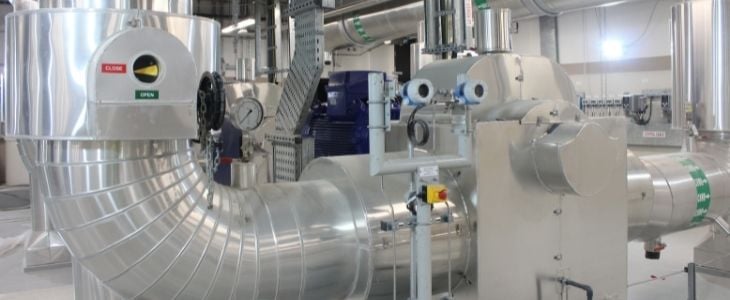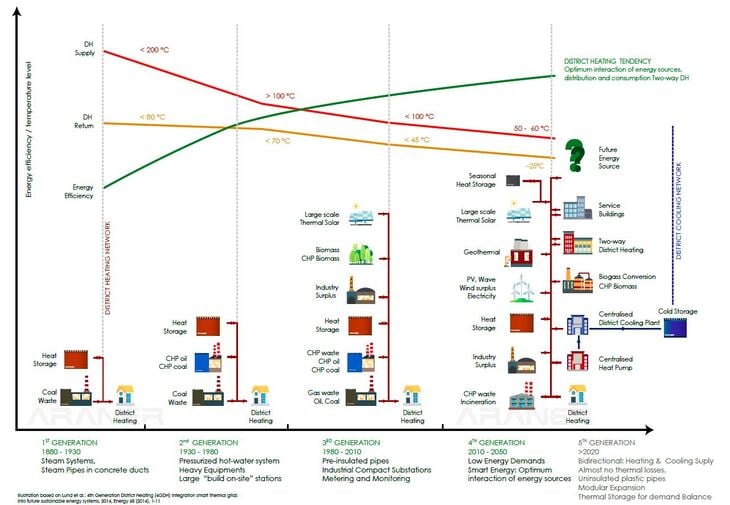5th generation district heating and cooling (also known as 5GDHC) represents a new stage in district heating and cooling systems in which energy efficiency and decarbonization are brought a step further.
The 5th generation heat network and its counterpart cooling systems have grown in light of stricter regulations in terms of building energy consumption as well as enhanced citizen focus on environmental impact and economic performance.
Technological developments have allowed the development of 5th generation district heating and cooling models.
But what is 5GDHC exactly and what advantages do these systems entail? From our decades-long commitment to district heating and cooling systems, at Araner we provide a short guide about the fifth generation.

What is 5th generation district heating and cooling
District heating and cooling systems have been around for a long time in charge of generating and distributing heat and cooling from a centralized location. They fulfill residential and commercial heating requirements.
Technology advancements and an improved environmental conscience have meant continuous shifts in this heating and cooling model, which are now moving away from fossil fuels and finding alternative, more sustainable and efficient energy sources.
Characteristics of the 5th generation district heating
After the previous four generations, the time has come for the 5th generation district heating and cooling, a model that can be defined by its distinct characteristics:
- Bidirectional, using an exchange of warm and cold return flows. This means buildings with different needs are able to exchange thermal energy so that energy losses are reduced and efficiency enhanced. This allows for a number of benefits, including the use of low-grade renewable energy sources, which were not employed in the past.
- Works with lower temperatures which are close to ground temperatures. While conventional district heating and cooling systems rely on delivering hot water at temperatures of around 80Cº, 5GDHC models operate at lower temperatures (around 50Cº). This brings in additional advantages, such as minimizing heat losses and economic costs.
In short, 5th generation district heating and cooling allows for an enhanced efficiency: a reduction of up to 75% in heat losses has been documented.
How does 5GDHC work
- Storage technologies. The development of 5th generation district heating and cooling has come at a time when aiding technologies have also been developed, such as thermal storage tanks.
- Closed energy loops. In order to maximize energy efficiency and thus allow renewable resources in, energy is reused and shared between different elements in the structure. This means no energy is wasted, as it can be exchanged within a building and at a neighborhood level as well, adjusting to different needs and demands simultaneously and even at different seasons. A hot and cold exchange can thus take place, also aided by the possibility of thermal storage tanks.
- Low-grade sources. High-grade energy sources are not required for the 5GDHC model, which seeks energy efficiency that leads to lowering energy demand. This is partly because 5th generation district heating and cooling operates at lower temperatures than traditional district heating and cooling systems. This possibility opens the door to renewable, decarbonized energy sources, such as geothermal, industrial waste, sewage water, large capacity heat pumps… In other words, 5th generation district heating and cooling is thus possibilitating the use of decarbonized, versatile energy sources. Additionally, local energy sources are prioritized. This means costs and needed investments are often minimized, while reliability is optimized.
- Decentralized. District heating and cooling systems that adopt fifth generation developments are taking decentralization a step further. This means they avoid unnecessary energy production and only generate and circulate energy when demand occurs. These demand-centered systems thus avoid energy losses, as heating and cooling can be delivered simultaneously to different customers at different temperatures following real-time demand.
- District heating & District Cooling differences. The working mode described above also has consequences for the different ways heating and cooling are delivered to individual buildings. As such, 5th generation district heating and cooling don’t present a conventional energy center. Instead, each building is connected through pipes to the network that supplies both heat and cold. When cooling energy is demanded, heat pumps work to eliminate heat.

Why is a 5th generation heat network more sustainable than other options
- 5th generation district heating and cooling is bringing decarbonization goals closer, pushing cities’ efforts for cleaner air and the fight against climate change. This is because this new generation of district heating and cooling systems is facilitating the embrace of cleaner, renewable sources instead of fossil fuels.
- Circular economies can also be developed thanks to 5GDHC. Based on a decentralized generation of cold and heat, 5th generation district heating and cooling allows for the introduction of local energy sources which, in turn, generate a number of circular developments:
- Energy loops create no-waste policies and make the most of already-produced energy.
- These energy loops also promote a new key role: the prosumer. As they exchange energy depending on specific needs, buildings can be understood as both consumers and producers of energy.
- Versatility in choosing energy sources means cities can explore different energy sources depending on availability. From waste heat to sewage water to geothermal or solar sources, direct dependence on the import of fossil fuels is minimized and local economies reinforced.
- Global efficiency is improved in terms of energy demand. More efficient heat pumps and the generation of zero-waste energy loops mean less energy is needed to generate comfortable atmospheres in buildings, bringing an additional sustainability benefit thanks to the development of 5th generation district heating and cooling.
At Araner, we develop pioneering and innovative solutions in district heating and district cooling.
As such, we’re part of the exciting new possibilities of 5th generation district heating and cooling models, aided by our state-of-the-art thermal storage solutions and large scale heat pump models.
As such, we work to help developers improve their project’s efficiency and reach decarbonization goals. Want to learn more about 5GDHC and what advancements are being made in district heating and cooling systems that lead to increased efficiency? Get in touch with us and let’s talk about how we can help you.










